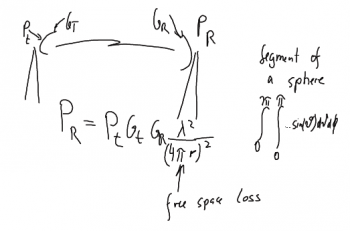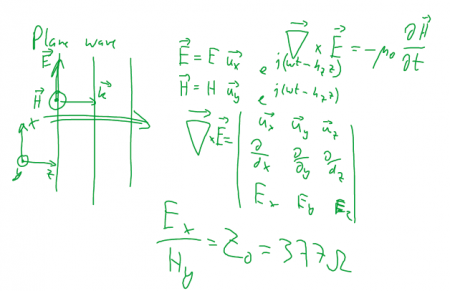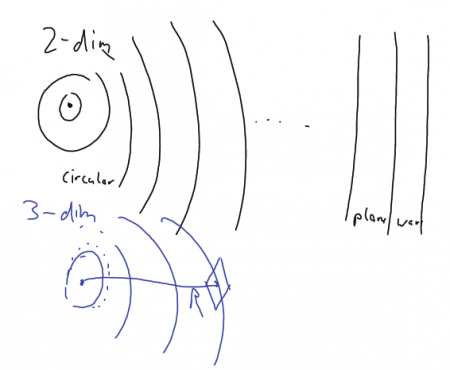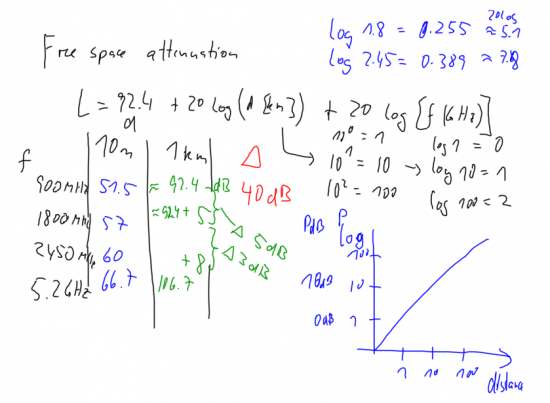Difference between revisions of "B1-Free Space Propagation"
From its-wiki.no
Josef.Noll (Talk | contribs) |
Josef.Noll (Talk | contribs) |
||
| Line 15: | Line 15: | ||
==⌘ Free space propagation == | ==⌘ Free space propagation == | ||
<span style="color:#000B80"> develop propagation equation</span>, see (http://www.antenna-theory.com/basics/friis.php) | <span style="color:#000B80"> develop propagation equation</span>, see (http://www.antenna-theory.com/basics/friis.php) | ||
| + | |||
| + | Power received in an area in a distance R from transmitter: | ||
| + | |||
| + | * area of a sphere is <math> A_s = 4*\pi*R^2 </math> | ||
| + | * power transmitted from isotropic antenna is <math> P_t </math> | ||
| + | * antenna area of receiver is <math> A_r = \lamda^2/4\pi </math> | ||
| + | * power received in A_r = P_r | ||
| + | |||
| + | <math> P_r = P_t * A_r / A_s = P_r = P_t * A_r / (4*\pi*R^2) </math> | ||
| + | |||
| + | thus | ||
<math>P_r = P_t \ G_t\ G_r\ \left (\frac{\lambda}{4\pi r} \right )^2\cdot </math> | <math>P_r = P_t \ G_t\ G_r\ \left (\frac{\lambda}{4\pi r} \right )^2\cdot </math> | ||
| Line 22: | Line 33: | ||
* <span style="color:#000B80"> discuss influences on radiation pattern</span> | * <span style="color:#000B80"> discuss influences on radiation pattern</span> | ||
| + | '''How much is 0 dB_m and 10 dB_m?''' | ||
| + | * Convert dBm to mW is: mW = 10^(x/10), x = number of dBm | ||
| + | * Convert mW to dBm is: dBm = 10*log10(y), y = number of mW | ||
| + | |||
| + | '''So you get:''' | ||
| + | * 0 dBm = 10^(0/10) = 1 mW | ||
| + | * 10 dBm = 10^(10/10) = 10 mW | ||
| + | |||
| + | |||
Free space attenuation | Free space attenuation | ||
<math>L = 92,4 + 20 \log(d \mathrm{[km]}) + 20 \log(f \mathrm{[/GHz]}) </math> | <math>L = 92,4 + 20 \log(d \mathrm{[km]}) + 20 \log(f \mathrm{[/GHz]}) </math> | ||
| Line 34: | Line 54: | ||
Calculation of free space attenuation. Note the increased free-space attenuation of approx 5 dB from 900 to 1800 Unik/MHz, and a further increase of 3 dB from 1800 (GSM 1800) to 2450 Unik/MHz (802.11b). Note also that increasing the distance by a factor of 10 will increase the power requirements by 20 dB. | Calculation of free space attenuation. Note the increased free-space attenuation of approx 5 dB from 900 to 1800 Unik/MHz, and a further increase of 3 dB from 1800 (GSM 1800) to 2450 Unik/MHz (802.11b). Note also that increasing the distance by a factor of 10 will increase the power requirements by 20 dB. | ||
| + | |||
| + | Free space propagation | ||
| + | Calculation: http://spreadsheets.google.com/pub?key=p0EyjWrbirGKJXK43uluJfg | ||
Revision as of 09:14, 21 September 2014
| Wiki for ITS | ||||||
|---|---|---|---|---|---|---|
|
Contents
⌘ Background: Wave Propagation
⌘ Task: Plane wave propagation
Assume a plane wave: . Show that
What is the relation between a plane wave and an omnidirectional wave?
⌘ Free space propagation
develop propagation equation, see (http://www.antenna-theory.com/basics/friis.php)
Power received in an area in a distance R from transmitter:
- area of a sphere is
- power transmitted from isotropic antenna is
- antenna area of receiver is
- power received in A_r = P_r
thus
- convert into dB
- provide examples for f = 10 MHz, 1 GHz, 100 GHz
- discuss influences on radiation pattern
How much is 0 dB_m and 10 dB_m?
- Convert dBm to mW is: mW = 10^(x/10), x = number of dBm
- Convert mW to dBm is: dBm = 10*log10(y), y = number of mW
So you get:
- 0 dBm = 10^(0/10) = 1 mW
- 10 dBm = 10^(10/10) = 10 mW
Free space attenuation
⌘Comments

|
Free space propagation from a transmit (t) to a receive (r) station. |
Calculation of free space attenuation. Note the increased free-space attenuation of approx 5 dB from 900 to 1800 Unik/MHz, and a further increase of 3 dB from 1800 (GSM 1800) to 2450 Unik/MHz (802.11b). Note also that increasing the distance by a factor of 10 will increase the power requirements by 20 dB.
Free space propagation Calculation: http://spreadsheets.google.com/pub?key=p0EyjWrbirGKJXK43uluJfg


